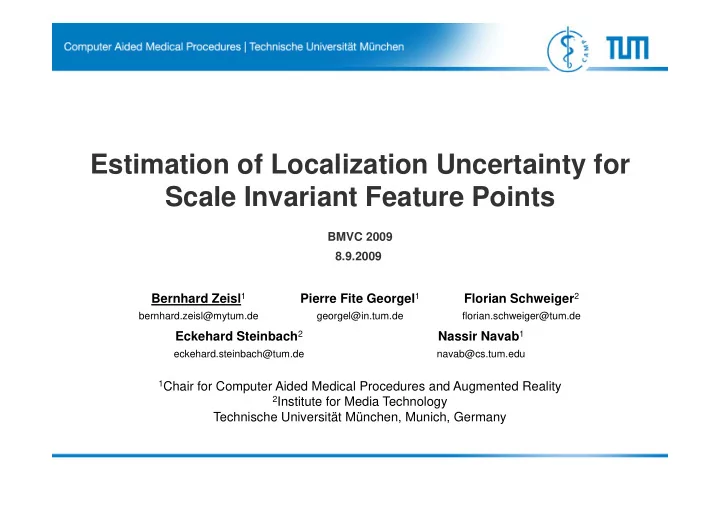

Estimation of Localization Uncertainty for Scale Invariant Feature Points Scale Invariant Feature Points BMVC 2009 8 9 2009 8.9.2009 Bernhard Zeisl 1 Pierre Fite Georgel 1 Florian Schweiger 2 b bernhard.zeisl@mytum.de h d i l@ d georgel@in.tum.de l@i d florian.schweiger@tum.de fl i h i @ d Eckehard Steinbach 2 Nassir Navab 1 eckehard.steinbach@tum.de navab@cs.tum.edu 1 Chair for Computer Aided Medical Procedures and Augmented Reality 2 Institute for Media Technology Technische Universität München, Munich, Germany
1 2 3 4 5 6 Introduction Motivation and Problem Statement Local features are state-of-the- art for a number of computer vision problems, e.g.: Object detection and localization Object recognition and Image retrieval Wide baseline matching and 3D reconstruction 3D reconstruction Common assumptions for detected local features: p Accurately detected or same deviation in localization error ( ) Does not hold for image detectors searching in scale space. 2
1 2 3 4 5 6 Introduction Motivation and Problem Statement Repeated detection of same local feature under noise in the image: g Our method: Estimation of individual localization error for each feature found parameterized by a covariance matrix parameterized by a covariance matrix. Kanazawa, Y., Kanatani, K., Do we really have to consider covariance matrices for image features? , ICCV 2001 3
1 2 3 4 5 6 Agenda Invariant Local Feature Detection Uncertainty Estimation Framework Experiments and Results Conclusion 4
1 2 3 4 5 6 Localization Error Inaccuracy is caused by pixel noise and the detection algorithm itself Pixel Intensity Noise Detection Algorithm Noise in pixel intensity values results from Noise in pixel intensity values results from Feature point detection algorithms use Feature point detection algorithms use the image capturing process. approximations in their calculation for complexity reasons. In different images a ground truth point will Additional error introduced for the feature be mapped to different points . point depending on the algorithmic noise. point depending on the algorithmic noise 3D ground truth point noise 1. Noise in captu- detection ring process 2. Location inaccuracy y in detection process 5
1 2 3 4 5 6 Scale Invariant Feature Detection The same feature can be detected at different scales Scale Space Representation Characteristic Scale Selection p Image / detector response stack Mikolajczky, K., Schmid, C., Scale & Affine Invariant Interest Point Detectors , 2004 6
1 2 3 4 5 6 Uncertainty Evaluation Framework Covariance is estimated from the detector response curvature Residual at feature point: Covariance based on Hessian: low curvature error due to the missing discriminative behavior of in . high curvature detection process more accurate high curvature detection process more accurate Kanazawa, Y., Kanatani, K., Do we really have to consider covariance matrices for image features? , ICCV 2001 7
1 2 3 4 5 6 Framework Application Application is identical for SIFT and SURF SIFT SURF Detector function Detector function Covariance calculation calculation Back projection 8
1 2 3 4 5 6 Statistical Error Modeling Maximum likelihood estimate and our covariance coincide (+) distribution of location error (--) our covariance estimate (- -) maximum likelihood estimate The covariance estimates fit the modeled error distribution Schweiger, F. et. al., Maximum Detector Response Markers for SIFT and SURF , VMV 2009 9
1 2 3 4 5 6 Covariance Dependence on Scale Feature points are localized better on smaller scales SIFT SIFT SURF SURF Change of Frobenius norm over detection scale for feature points detected in real images. Feature points with small ( Feature points with small ( ) and large ) and large ( ) covariances. Blobs are worse localized than distinctive image points image points. 10
1 2 3 4 5 6 Covariance Dependence on Scale Covariances imply automatic scale normalization High and low Covariances of matching feature points in the two images: (covariances are projected with the underlying homography) resolution images: 3072x2304 pixel SIFT SURF Corresponding feature points are detected at different scales; but (projected) covariances of features are almost identically Localization error is similar in both images in relation to their size 800x600 pixel Covariances normalize and weight the error in an optimization and thus differently sized images can be used sized images can be used 11
1 2 3 4 5 6 Results for Model Fitting Bundle Adjustment Bundle adjustment simultaneously refines the 3D coordinates describing the scene geometry as well as camera poses and intrinsic camera parameters. M j M j p 1 j p 1 j p 2 j p 2 j [ R t ] [ R t ] [ R t ] 12 [ R t ] 12 C 1 C 1 C 2 C 2 K [ R t ] 1 = K [ I 0 ] K [ R t ] 1 = K [ I 0 ] K [ R t ] 2 K [ R t ] 2 Euclidian distance: Euclidian distance: Mahalanobis distance: Triggs, B. et. al., Bundle Adjustment - A Modern Synthesis , Lecture Notes in Computer Science 1999 12
1 2 3 4 5 6 Bundle Adjustment Performance is evaluated with the reprojection error of corner points Reprojection error of 3D corner points: Mean performance as pixel offset for about 100 different image pairs: We get a performance improvement for the reconstruction with bundle adjustment using our feature point covariances. g 13
1 2 3 4 5 6 Conclusion Main Contributions Derivation of general formulation for feature detection in scale space Derivation of general formulation for feature detection in scale space Computation of stable covariances for scale invariant image features Justification of correctness for our covariance estimates Inherent scale normalization Performance improvement for bundle adjustment We would like to encourage you to test and use our results: Code and binaries for SIFT and SURF local feature detection and covariance estimation are available at: http://campar.in.tum.de/Main/CovarianceEstimator 14
Recommend
More recommend